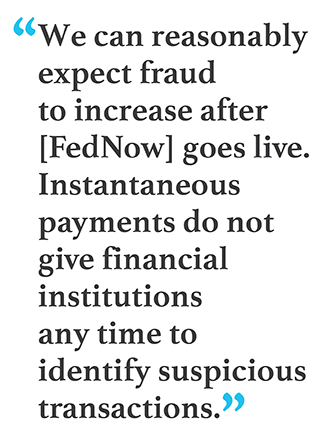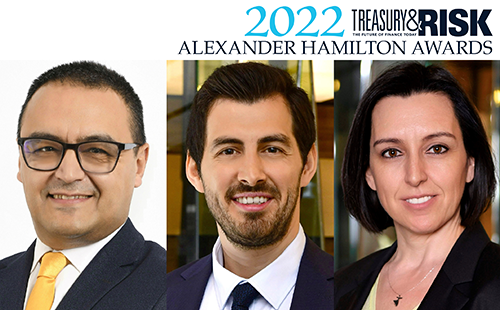
Faster and smoother payment processes may eliminate float forcorporate payables teams, but they also provide enormousopportunities to streamline processes and gain much more precisecontrol over cash balances. That's why most corporate treasurerslove the idea of being able to initiate and finalize transactionsin seconds, rather than waiting days for them to clear.
|Back in August, the U.S. Federal Reserve announced plans to takethe first step toward instantaneous payments in the U.S. market.Since then, the Fed has been working to build out a real-timepayments settlement system, which will be called the FedNowservice. In the announcement, Fed governor Lael Brainard explainedthis move by saying: "Everyone deserves the same ability to makeand receive payments immediately and securely, and every bankdeserves the same opportunity to offer that service to itscommunity. FedNow will permit banks of every size, in everycommunity across the country, to provide real-time payments totheir customers."
|The Fed describes FedNow as a way to modernize the nation'spayment system. Widespread adoption of FedNow would render obsoletethe Automated Clearing House (ACH) framework that currently settlesinterbank transactions.
|The initiative is a response to the express desires of bigbrands like Amazon.com and Walmart, which have advocated for fasterpayments resolution. One recent study by Aite Group found that 80percent of business owners are interested in the possibility ofinstant funds transfers. Furthermore, 85 percent of respondents tothe survey said they would be willing to change to a new acquiringbank if doing so meant having access to instant card receiptfunding.
|Thus, it should come as no surprise that the announcement ofFedNow seems to be drawing overwhelming popular support. TheFederal Reserve reported that 90 percent of respondents in theidea's public comment period were in favor of the initiative.Still, corporate treasury and finance groups should proceedcautiously.
||
New Processes Create Uncertainty
FedNow adoption is anticipated to begin sometime in 2023 or2024. According to the Federal Reserve, FedNow will resolvetransactions between financial institutions by adjusting the banks'master accounts at the reserve banks to which the institutions aredepositors. In turn, the banks will agree to make transaction fundsavailable to their customers immediately. For companies, this meansmore prompt resolution of transactions and, as a result, reducedfloat and more accurate, reconcilable accounting.
|In some ways, the service will include natural protections frompayment fraud. Faster payments can make it harder for fraudsters tointercept payments. In addition, the Fed intends to promote "resiliency throughredundancy," allowing banks to build backup networks for paymentssettlement in the event of a disruption.
| However, I remain concerned thatFedNow will not effectively prevent fraud. In fact, we canreasonably expect fraud to increase after the platform goes live.That is because instantaneous payments do not give financialinstitutions any time to identify suspicious transactions. In theexisting payments environment in the United States, the clearingprocess involves each institution maintaining its own record oftransactions and verifying its record against those of fellowstakeholders. This process calls for considerable back and forth,with different parties communicating and attempting to verify theirrecords, before we ever move to the actual process of debiting andcrediting individual accounts.
However, I remain concerned thatFedNow will not effectively prevent fraud. In fact, we canreasonably expect fraud to increase after the platform goes live.That is because instantaneous payments do not give financialinstitutions any time to identify suspicious transactions. In theexisting payments environment in the United States, the clearingprocess involves each institution maintaining its own record oftransactions and verifying its record against those of fellowstakeholders. This process calls for considerable back and forth,with different parties communicating and attempting to verify theirrecords, before we ever move to the actual process of debiting andcrediting individual accounts.
These due diligence practices are time-consuming and redundant.However, they fill a valuable role in that they weed out fraud anderrors. The banks have oversight processes that—while notperfect—at least ensure that individual transactions are probablyvalid. But when transactions close immediately after they'reinitiated, banks simply do not have time to complete this duediligence process. If bad actors are able to intercept atransaction and divert funds, by the time the parties involvednotice the fraudulent activity, the company's money might beimpossible to recover.
|Concern about fraud in a real-time payment environment is morethan idle speculation. We can look to the U.K. as an example; in2008, the Faster Payments Service (FPS) was adopted, creating aninstant payments service similar to FedNow. Since FPS went live,U.K. officials have consistently observed larger losses from onlinebanking fraud. The report Fraud the Facts 2019 report from UKFinance projects that U.K. bankers will prevent £318 million inbanking fraud attempts this year. However, £152 million will stillgo unnoticed.
||
Process Uncertainty Drives Risk
FedNow is a rebuilding of U.S. payment processes from the groundup. Its adoption will represent a major policy overhaul for thepayments space, and it's going to impact different parties indifferent ways. For corporate treasuries, fraud will be the primaryconcern.
|The largest impact of the new system for consumers will likelycome in the handling of chargebacks. U.S. law guarantees merchantsthe rights to dispute charges and recover their money in the eventof fraud. The process fills an important role in our financialsystem because it supports cardholder confidence in payment cards.However, the chargeback process is widely abused. Chargebacks cost $31 billion in 2017, and those costscontinue to rise each year.
|Both payments fraud and chargeback fraud are able to flourishlargely because the U.S. financial market lacks standards andconsistency of practices across different card schemes (Visa,Mastercard, etc.). Card providers in each scheme have their ownprocess for managing disputes, which creates confusion andunnecessary complexity. At present, each card scheme also hashundreds of pages of rules and procedures for managing thechargeback process, some of which are older than e-commerceitself.
|Before we can start talking seriously about instantaneouspayments in this country, the financial services sector mustdevelop universally applicable processes for managing fraud anddisputes—and consistent, fair guidelines for handling chargebacks.We need simplified, modernized procedures that can be universallyapplicable across card brands. This will cut down on abuse andenable more consistent dispute outcomes. It won't be easy to do;developing a modernized chargeback procedure requires coordinationand input from merchant representatives, banks, card schemes,consumer groups, and regulators. However, any efforts to improvethe payments process that don't address chargebacks are basicallyjust rearranging deck chairs on the Titanic.
||
Frontline Dispute Mitigation
In the meantime, merchants will need to take action to mitigatetheir chargeback risk. Best practices on this front include:
||
1. Embracing multilayer frauddetection. All chargebacks can be traced to one ofthree fundamental sources: criminal fraud, friendly fraud, ormerchant error. Before addressing the latter two, sellers musteliminate criminal fraud wherever possible. This calls for amultilayer strategy; incorporating redundancies into a strategywith complementary detection tools will help. Back-end frauddetection tools like Address Verification Service (AVS), velocitylimits, fraud scoring, and geolocation can identify potential fraudwithout increasing customer friction. There are also opt-in toolslike 3-D Secure, which functions like an online PIN code atcheckout.
||
2. Emphasizing customer service andexperience. As merchants take steps to mitigatecriminal fraud, they should also review the customer experiencefrom end to end to optimize practices and procedures. Simple stepslike providing prompt responses to email, social media, and chatbotinquiries, as well as providing detailed descriptions of productsand services, can have a tremendous impact on chargebackissuances.
|Merchants should make all policy disclosures easily accessibleto customers and should adhere closely to those policies. Thisestablishes clear expectations for buyers and educates them on howbest to interact going forward.
||
3. Being cognizant of friendlyfraud. If businesses do everything they can tomitigate the risk of criminal fraud and error, it stands to reasonthat most of their remaining chargebacks would be cases of friendlyfraud. This is a kind of chargeback abuse, and while it can beintentional, it's often the result of factors like buyer's remorse,confusion about merchant policies, or a lack of understanding onthe customer's part.
|It's difficult to prevent these problems, given theirpost-transactional nature; they don't become fraud until thecustomer files a chargeback. That said, using deliveryconfirmation, ensuring all billing descriptors are easy toidentify, and monitoring digital goods sales can help merchantscurtail friendly fraud.
|When a customer manages to file a friendly fraud dispute, it'simportant to identify the abuse and engage it through tacticalrepresentment. Of course, chargeback representment is an involvedand complex process, which is why many opt to seek third-party helpfrom a chargeback management service.
|
 Monica Eaton-Cardoneis COO of Chargebacks911 and CIO ofits parent company, Global Risk Technologies. She has extensiveexperience developing agile technologies and products, optimizinge-commerce profitability, analyzing risk relativity, and creatingpayment processing solutions.
Monica Eaton-Cardoneis COO of Chargebacks911 and CIO ofits parent company, Global Risk Technologies. She has extensiveexperience developing agile technologies and products, optimizinge-commerce profitability, analyzing risk relativity, and creatingpayment processing solutions.
Complete your profile to continue reading and get FREE access to Treasury & Risk, part of your ALM digital membership.
Your access to unlimited Treasury & Risk content isn’t changing.
Once you are an ALM digital member, you’ll receive:
- Critical Treasury & Risk information including in-depth analysis of treasury and finance best practices, case studies with corporate innovators, informative newsletters, educational webcasts and videos, and resources from industry leaders.
- Exclusive discounts on ALM and Treasury & Risk events.
- Access to other award-winning ALM websites including PropertyCasualty360.com and Law.com.
*May exclude premium content
Already have an account? Sign In
© 2024 ALM Global, LLC, All Rights Reserved. Request academic re-use from www.copyright.com. All other uses, submit a request to [email protected]. For more information visit Asset & Logo Licensing.






